Dr Sunil Abhiman Awachar is clearly an antithesis to discourse on contemporary Indian art.
By Yogesh Maitreya, TwoCircles.net,
New Delhi: Dr. Sunil Abhiman Awachar is well known as a poet and painter, also an assistant professor with the Department of Marathi in University of Mumbai. Meanwhile, he is full time activist in dalit human rights movement. He has published four anthologies of poetry, all in Marathi, that include ‘Global vartamanachya kavita (2008)’ ‘Mi mahasattechya darashi katora gheun ubha rahanaar nahi,’ ‘Bravo! Fox minds of capitalist’ and ‘Poems of the occupied everything’.
One of the anthologies of his poems has translated into English as ‘Our world is not for sale’. His poems voice out political statements which demand the social justice. And the language of his poems is the unique blend of local languages in India which are being obscure from people’s imagination: Mahari, Gondi and Banjara. He is also in a pursuit to reinforce and recreate the imaginary in these languages.
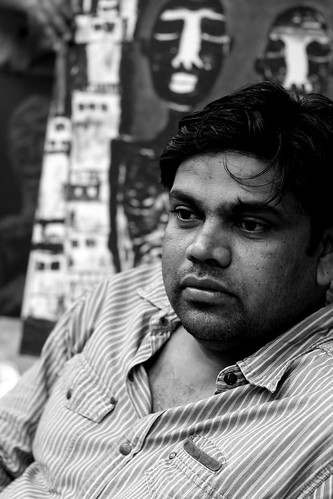
Sunil Abhiman Awachar
Sunil’s uniqueness of Art lies in his pre-occupied empiricism of dalit lives that reflects in his poetry as well paintings. Hails from a small village of vidarbha, the region infamous for most numbers of farmer suicides and dalit atrocities like Khairlanji, his artistic is difficult to theorise into any available principles of aesthetic. The subjects of his poems are post-modernists, the characters and themes of his paintings are people who are neglected into consensus as well government’s welfare schemes.
Having created discipline of his own, his poems pose a great challenge and argue with oppressor, questions the system of caste in which he states: Those who morphed human being/ For ‘Bread’ into a pet dog/ I will call them criminals of mankind/ I think / Instead of becoming Master’s dog/ Why not have war for the/ Free distribution of ‘Bread’?
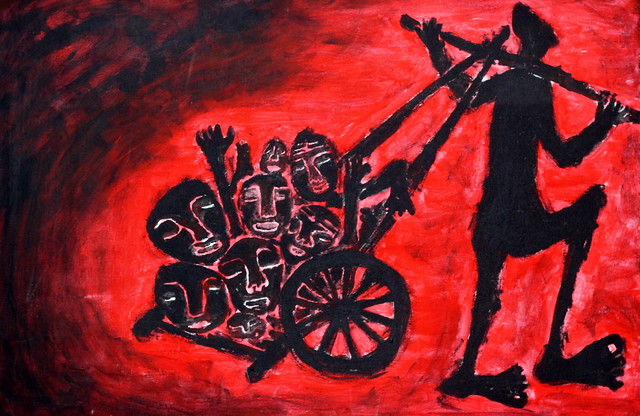
Recently, his paintings have been exhibited at Tata Institute of Social Sciences, Mumbai on the occasion of Dr. Ambedkar Memorial Lecture. Dr. Sunil Abhiman Awachar isn’t a painter with the conventional values of aesthetic of paintings that has been practiced and produced in India in recent as well as earlier times. Penetrating closely, his values of aesthetic belong to the legacy of Ajanta. The subjects as well as aesthetic elements of his paintings unsettle the perception of a viewer at first sight. Further, observing closely, his paintings bring forth the different world before the eyes of the viewers. Whose world is this anyway? Is this world familiar to one in which we live? The world he portrays in his paintings is the world of broken people. They are underground amid the ‘conventional’ society. They are not in the sight of media, not a subject of Art events, or not being appreciated in literary festivals of ‘mainstream/elite’ yet tiny literary circles of India.
These people can only be referred as ‘other people’. Dalit/Bahujan/ Adivasis are few nomenclatures given to these ‘other people’ and this is how they have been discussed in academic discourses. But Dr. Sunil Abhiman Awachar seems well set to create the hidden aesthetic of these people through his paintings. In his paintings, the forms of head, leg, fingers, eyes, torsos, etc are something powerful yet unshaped even grotesquely unrefined which illustrate the origins of untouchability in which untouchables were so powerful with the physical existence yet neurotic system of caste kept them into incessant incarceration.
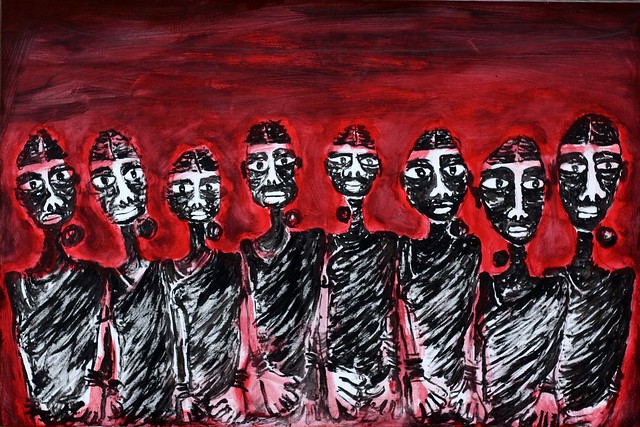
Inspired by Dr BR Ambedkar and his vehement struggle against caste and its menace, Dr. Sunil Abhiman Awachar goes on to choose the subjects for his paintings which can be seen into subaltern spaces of both urban as well as rural area. In his paintings, he exposes these people with the crafted ease, colouring their exploitation in the simplest colour scheme, sometimes starkly read or black. His paintings produce the new statements of the ‘globalised’ India in which these ‘other people’ are still waiting for their liberation. Having legacy of struggle against caste and its modernist trajectories of exploitation behind him, Dr. Sunil Abhiman Awachar finely depicts his experiences through the characters he represents into his paintings. At the theoretical domain, his paintings are finest combination of empiricism and theoretical insights which can be found in his poetry too.
It’s not only that he represents the exploitative aspects of these people in his paintings, the pursuit of social justice is also an embedded as conceptual subconscious behind his paintings, which means, his paintings are not only depicts the origin of exploitation emanates from untouchability, but they are into the constant pursuit of liberation and freedom. It is at this juncture, his paintings and poetry go global. Whether Javkheda, Kharda, Khairlanji atrocities against dalits or Fergusson episode of racist exploitation from U.S.A, his paintings collectively find the new colours and shapes them to depict the gravity of these incidences. His paintings are the aesthetic-voice of people whose voice is incarcerated by system of caste.
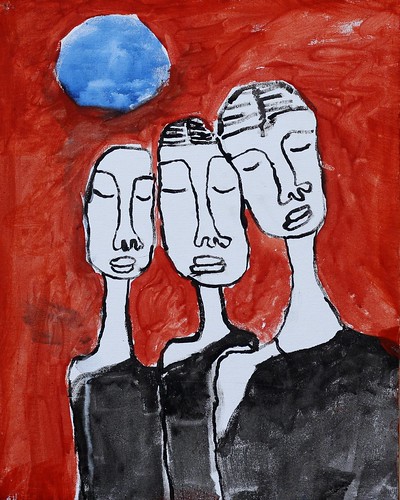
The contemporary Indian discourse of Art, with reference to paintings, is dominated by the shallow and fine approach of aesthetic sensibilities. Dr. Sunil Abhiman Awachar is clearly an antithesis to this discourse. His paintings not only discover the language of these ‘other people’ in the domain of Art; it also challenges and breaks the ‘conventional’ norms to perceive piece of painting. The explosive depiction of brawny people in the language of aesthetic distinguishes him from others. And it is here, these people transformed into a force, a resistance, unstoppable language of their artistic sensibilities.
And in doing this, he has no claim of belongingness in a sense that you could not find his name over his painting. And when ask, why he doesn’t have his name over his paintings, he would certainly narrate his famous conviction about it: do you find the name of painters in Ajanta. Why, have you think on it? Because these paintings were the representation of the people, their beauty, their life and they were not for ownership or for sale. These paintings were the paintings of people, and they belong to them only.
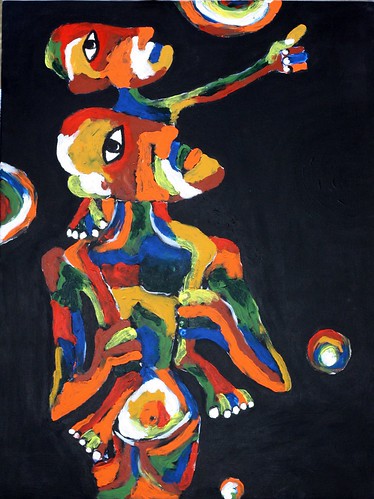
Turning out to be a poetic rebel and optimist, he says:
I am waiting for such a poet
Who will resign from company-slavery
And,
Turned out to be a rage of people’s mind.
I am waiting for such a day
And such a poet.
That poem will certainly be ours
Which will search the culprit of our suffering
Note: Poems are translated by Yogesh Maitreya for the purpose of the article. Photos are taken by Daisy Katta
———
(Yogesh Maitreya is doing his M.A in Criminology and Justice (2013-15) from TISS (Tata Institute of Social Sciences, Mumbai.)

